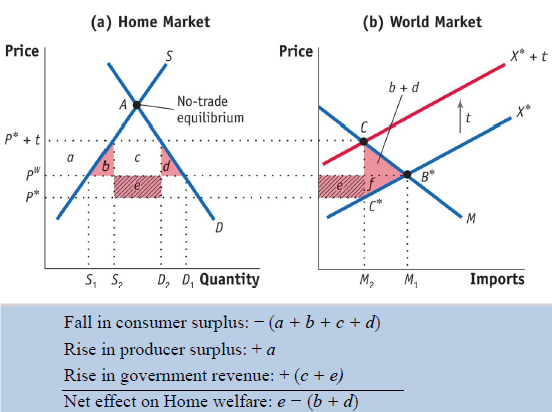Reader Bruce Hall, opining on the impact of mooted Chinese tariffs on US hog and soybean exports.
As with pork, it looks as if the cost of food is going down for Americans as the Chinese bury their citizens in food price increases.
I’m teaching international trade this semester, so this is a good time to remind my students: a tariff’s incidence when the home country is large depends on the relative size (and elasticities) of the import demand and export supply curves.
For instance, a 25% tariff on US soybeans, could result in a 25% increase in prices of imported soybeans in China. Or it could result in 0% if the US is a very small supplier in global markets. Well, the US is pretty large (largest single exporter), so let’s say 15% of the tariff is reflected in Chinese prices. The other 10% is reflected in US prices, both domestic and foreign (as long as there is no other segmentation imposed). I wonder at the equanimity of those contemplate from the safety of afar what 10% price reduction means. See slide 23 of this lecture presentation, presented below. Interpret “home” as China in this context.

Figure 1: Impact of a tariff in a large country, in home market, world market.
In other words, China will impose a terms of trade loss on the US, since it is a substantial purchaser of soybeans. It is incorrect to conclude that China will, unambiguously, incur a net loss.
Tariffs on Gross Value vs. Value Added
While the dollar amount trade covered by retaliation proposed by the Chinese is roughly the same as that of the US under Section 301 (around $50 billion), the tariffs of 25% is on gross value. This matters, since it’s likely for most of the imports from the US to China, the US value added is close to 100%. On the other hand, as noted in this post, roughly 50% of the value of US imports from China is foreign sourced. Taken literally, a 25% tariff on gross value works out to 50% tariff on Chinese value added. Of course, it might be that the Chinese value added in the imports covered by the Section 301 tariffs is a higher proportion than 50% (phones were excluded, for instance). Still, the nominal 25% tariff is likely to translate into a higher tariff rate on Chinese value added. So the pain inflicted on Chinese exporters targeted is higher than that on American exporters, ceteris paribus.











Leave A Comment